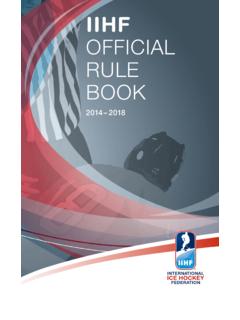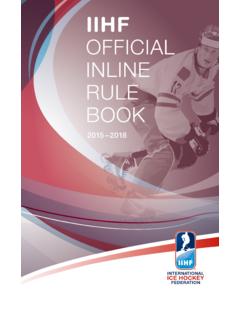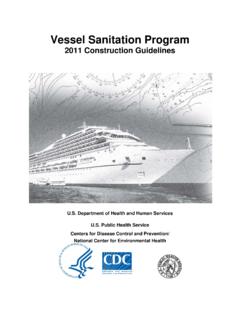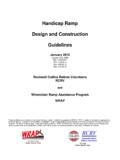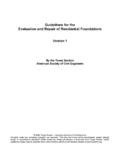Transcription of Technical guidelines of an ice rink
1 INTERNATIONAL ICE HOCKEY FEDERATION. Technical guidelines of an ice rink Chapter 3. General introduction rain : humid air will condensate on the cold Ice rink facilities share all the same con- inner surface of the ceiling and the dripping cerns: energy usage, operating costs and indoor starts. The ceiling is cold because of the radiant climate. Ice rink design and operation are totally heat transfer between the ice and the ceiling unique and differ in many ways from standard the ice cools down the inner surface of the ceil- buildings. Thermal conditions vary from -5 C on ing. Though there are Technical solutions to mini- the ice surface to +10 C in the stand and +20 C mize the indoor rain problem (low emissive coat- in the public areas like dressing rooms and offices. ings) the ceiling only solution is still subjected 15. High humidity of indoor air will bring on corroding to weather conditions and high running costs. problems with steel structures, decay in wooden structures and indoor air quality problems like 2) The refrigeration plant is needed to make Chapter 3.
2 Fungi and mould growth etc. Obviously there are and maintain ice on the rink. Refrigeration special needs to have Technical building services plant includes the compressor(s), the condens- to control the indoor climate and energy use of an er(s), the evaporator(s), and rink pipes. The heat ice-rink facility. Advanced technology can reduce from the rink is sucked by the compressor via energy consumption by even 50 % and thus de- the rink pipes and the evaporator and then crease operating costs in existing and proposed released to the surrounding via the condenser. ice rink facilities while improving the indoor climate. The heat from the condenser can be used to Energy costs and concern about the envi- heat the ice rink facility and thus save consider- ronment sets high demands for the Technical ably energy and money. Refrigeration plant is solutions, without effective solutions the opera- the main energy consumer in the ice rink facil- tional (energy, maintenance, replacement) costs ity.
3 Compressors, pumps and fans needed in will increase and short service life time of such a the refrigeration system are normally run by system is expected from the environmental point electricity and their electricity use may cover of view. Potentially a lot of savings can be made if over 50 % of the total electricity use of an ice the facilities are got operating as energy-efficiently rink facility. as possible. This will require investment in energy- saving technology and in raising energy awareness 3) Mechanical ventilation is necessary to be on the part of ice rink operators. able to control the indoor air quality and thermal as well as humidity conditions in- The basic Technical elements of a well-working side the ice rink. Ventilation is needed both in facility are: the public spaces (dressing rooms, cafeteria, Insulated walls and ceiling etc.) and in the hall. If you ever have visited a Efficient refrigeration plant dressing room when the ventilation is off you Mechanical ventilation will realize the necessity of the proper ventila- Efficient heating system tion; the stink of the outfit of the hockey players Air dehumidification is unthinkable.
4 Inadequate ventilation will cause also health problems in the hall. To be energy- 1) Insulated walls and ceiling makes it possible efficient air renewal must be well controlled. to control the indoor climate regardless of This means that the ice rink enclosure should the outdoor climate. In an open-air rink the be airtight so that there are no uncontrollable operation is conditional on the weather (sun, air infiltration through openings (doors etc.). rain, wind) and the running costs are high. and roof-to-wall joints. Air infiltration will in- Depending of the surroundings there might crease energy consumption during the warm also be noise problems with the open-air rink and humid seasons related to refrigeration and traffic noise may trouble the training or the dehumidification and during the cold seasons slamming of the pucks against the boards may this is associated with space heating. This leads cause noise nuisance to the neighbourhood.
5 Us to the fourth basic demand: the ice rink Ceiling only construction helps to handle with facility must be heated. Unheated ice rink is sun and rain problems but may bring about freezing cold even in warm climates and maintenance problems in the form of indoor humidity control of the air becomes difficult. INTERNATIONAL ICE HOCKEY FEDERATION. Cooling coil Rink piping Coolant pump Heat recovery Energy consumption is in the key role when speaking of the life cycle costs and above all the environmental load of the facility during its life cycle. The key to the effective utilization of the Refrigeration Liquid energy resources in new as well as in retrofit and unit pump refurbishment projects is in the consciousness of Figure 1. Refrigeration plant, indirect cooling system. the energy-sinks and the various parameters affect- 16 ing the energy consumption. The construction, plant system and opera- tion define the energy consumption of an ice rink.
6 4) Ventilation offers also a means to heat the ice The construction characteristics are the heat and Chapter 3. rink. Heating the ice rink with air necessitates moisture transfer properties of the roof and walls, the use of re-circulated air and that the venti- as well as air infiltration through cracks and open- lation unit is equipped with heating coil(s). ings in the building envelope. The structure of the Remarkable energy-savings can be achieved floor is also important from the energy point of when using waste heat of the refrigeration view. Plant characteristics include the refrigeration, process to warm up the air. ventilation, dehumidification, heating, lighting and ice maintenance systems. The operational charac- 5) The dehumidification plant is needed in well- teristics are the length of the skating season, air working facility to dry the rink air. Excess mois- temperature and humidity, ice temperature, supply ture in indoor air will cause corrosion of metal air temperature and fresh air intake of the air-han- structures, rotting of wooden structures, fungi dling unit as well as the control- and adjustment and mould growth, increased energy consump- parameters of the appliances.
7 Figure 3 shows the tion and ice quality problems. energy spectrums of typical training rinks and figure 4 illustrates the energy flows of a typical small ice rink. Insulated exterior envelope Heating Enables to build an ice rink anywhere in Maintains acceptable thermal the world conditions Air tight envelope to avoid moisture Use heat recovered from the problems refrigeration plant (condenser heat). as much as possible Mechanical ventilation Dehumidification Refrigeration plant Provides good indoor Dehumidification prevents moisture Needed to make and maintain ice air conditions problems (fog, soft ice, damages to Pay attention to the energy Demand-controlled ventilation the building) efficiency of the plant (high COP). saves money and energy Dry ventilation air before entering the building Figure 2. The construction, plant system and operation define energy consumption of an ice rink. INTERNATIONAL ICE HOCKEY FEDERATION. Electricity Heat Compressor 47%.
8 Brine pumps & condenser fans 14% 17. Ice-surface lighting 12%. Lighting 2%. HVAC appliances (pumps, fans, controllers, etc.) 9%. Chapter 3. Other consumption Space heating 67%. (cafe, cleaning, outdoor lights, etc.) 12% Warm water 17%. Dehumidification 4% Melting the snow 16%. Figure 3. Main electricity and heat consumption components of a typical training facility. In an ideal situation the heating demand of heating system is needed to meet the heating the ice rink is totally covered with recovered heat demands when the compressors are not running from the refrigeration process. In practice extra for example during dry floor events (concerts, heat is still needed to cover the needs of hot tap shows, meetings, etc.). water and heating peaks. Moreover a backup Electricity Energy losses 900 MWh 600 MWh Heat 200 MWh Cooling energy Recovered 1300 MWh heat 800 MWh Surplus heat 1000 MWh Figure 4. While producing cold, the ice plant provides heat that can be utilized in space heating and hot water production.
9 Still there is a great deal of extra heat that could be made good use of for example in a nearby indoor swimming pool. INTERNATIONAL ICE HOCKEY FEDERATION. Sizing the ice rinks It is strongly than recommended that the There are several ways to classify ice sport first studies for a new ice rink will be done on a so venues and in this manual the definition will be called modular base, which allows in later years done on the basis of fixed seating capacity, size of possibilities for optional enlargements. These later the food service supply and multi-purpose possi- modifications could be like an additional ice pad, bilities. enlarged spectator stand or a restaurant. In order to make the optional features pos- 18 There fore the sizing of the ice sport venues are sible for later realization, the designer team should divided into three categories as follow: take into consideration some Technical features like: Small ice rinks with seating capacity up to 2000 Sizing of refrigeration unit Medium size ice arenas between 2000 and Main structural support system, where for ex- Chapter 3.
10 6000 seats with some multi-purpose features ample the columns and foundations on one side Modern multi-purpose ice arenas with over of the building are from beginning planned to 6000 fixed seats with a wide scale catering offer take later on extra load from additional structures and many possibilities for multi-purpose use Envelope structure, like external walls, should be at least partly removable Small ice rinks can be done without any fixed seating or any foodservice capability, although In this manual we are only concentrating the modern small ice rinks are without exception on a small ice rink by defining an IIHF prototype also concentrating on getting additional revenues ice rink with about 500 fixed seating and a small through special hospitality programs. restaurant. IIHF prototype definition Minimum required space, IIHF prototype ice rink In a small ice rink there is a minimum space needed for following use: at least one standard IIHF ice pad, size of 30 m x 60 m surrounded by a dasher board and glass protection with 1,5 m minimum space outside of the dasher board four dressing rooms incl.


